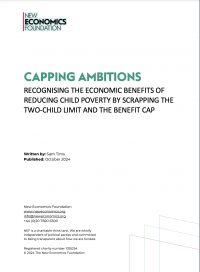Publications Capping ambitions Recognising the economic benefits of reducing child poverty by scrapping the two-child limit and benefit cap By Sam Tims 20 October 2024 Download the report The introduction of a cross-departmental taskforce dedicated to reducing child poverty is a positive signal of intent from the new government. The drivers of poverty are wide-ranging, and a serious government response must be as well. That the strategy will explore all available levers is welcome,
Topics:
New Economics Foundation considers the following as important:
This could be interesting, too:
Robert Vienneau writes Austrian Capital Theory And Triple-Switching In The Corn-Tractor Model
Mike Norman writes The Accursed Tariffs — NeilW
Mike Norman writes IRS has agreed to share migrants’ tax information with ICE
Mike Norman writes Trump’s “Liberation Day”: Another PR Gag, or Global Reorientation Turning Point? — Simplicius
Capping ambitions
Recognising the economic benefits of reducing child poverty by scrapping the two-child limit and benefit cap
20 October 2024
The introduction of a cross-departmental taskforce dedicated to reducing child poverty is a positive signal of intent from the new government. The drivers of poverty are wide-ranging, and a serious government response must be as well. That the strategy will explore all available levers is welcome, but this must not obscure the need to tackle the most direct drivers of child poverty. To ensure ambitions are not limited from the outset, the child poverty taskforce must acknowledge the ongoing harm that families are experiencing due to the inadequacy of the social security system the government has inherited.
For too long, social security and its associated costs have been viewed as something to be contained and cut. But if adequately funded and designed to provide genuine support, the income safety net can reduce poverty and prevent destitution, ease demand on other public services, and stimulate economic growth in areas where it has been most absent.
To realise the ambitions of the child poverty strategy, and to make a downpayment on its growth agenda, the new government should revoke the two-child limit and benefit cap. Ending these policies from April 2025 onwards will cost central government £2.5bn a year, rising to £3.5bn by 2029/30. The two-child limit constitutes the majority of these costs at £1.9bn and £2.6bn respectively. However, we argue that these costs will be significantly offset by short, medium and longer-term economic gains.
Overall, while the gains would not yet be fully realised, we estimate that the total cost of child poverty would be £3.0bn a year (7.1%) lower in 2025/26 if both policies were removed from April 2025. By the final year of the parliament, the total reduction in the cost of poverty would be £4.0bn a year (8.7%), with the two-child limit alone contributing £3.2bn (7.0%).
This is a much higher than the current estimates of the Office for Budget Responsibility (OBR). Based on the default fiscal multipliers employed by the OBR, gross domestic product (GDP) will increase by up to £1.5bn in the first year (depending on how the policy decision was funded), with the effects on GDP fading entirely after five years. If just the two-child limit was scrapped, the OBR would expect GDP to increase by £1.1bn in 2025/26.
We argue that the OBR should revisit the size and longevity of their fiscal multipliers for these policies, accounting for the specific impact on families most likely to live in poverty. Furthermore, in areas where significant numbers of people will benefit from the ending of these caps, consumer and, in turn, business confidence will increase, enabling employers to make more long-term, productivity-enhancing decisions. Constituencies in Birmingham, Bradford, and Bolton will be among the largest beneficiaries of scrapping the two-child limit, each receiving a stimulus in the region of £10m a year.
To properly account for the effects of poverty reduction, a wider set of factors should be considered over a longer timeframe by the OBR. In reducing child poverty rates, pressures on the NHS, schools, and social services will reduce, enabling the reallocation of resources to other areas of high demand. Not all these gains will materialise straightaway – the effects of poverty can be long lasting – but they are currently ignored entirely in OBR forecasts. We estimate that the reduction in child poverty in 2025/26 corresponds to lower demand for public services of £1.5bn a year over the medium-term. There are also real long-term gains to be realised. Reducing the poverty burden on children will lead to a healthier, better educated labour force in the future, increasing the productive capacity of the economy and unlocking higher earnings.
For those children who in 2025/26 would not grow up in poverty, or in as deep poverty, we estimate their future net earnings to be £920m a year higher, with an additional £490m returned to government through taxation and reduced spending on social security.
If these caps are retained, half of larger families (49.4%) are forecast to be living in relative poverty after housing costs by the end of this parliament. Removing the caps will reduce this by almost a sixth to 41.5%.
Topics Social security Inequality




